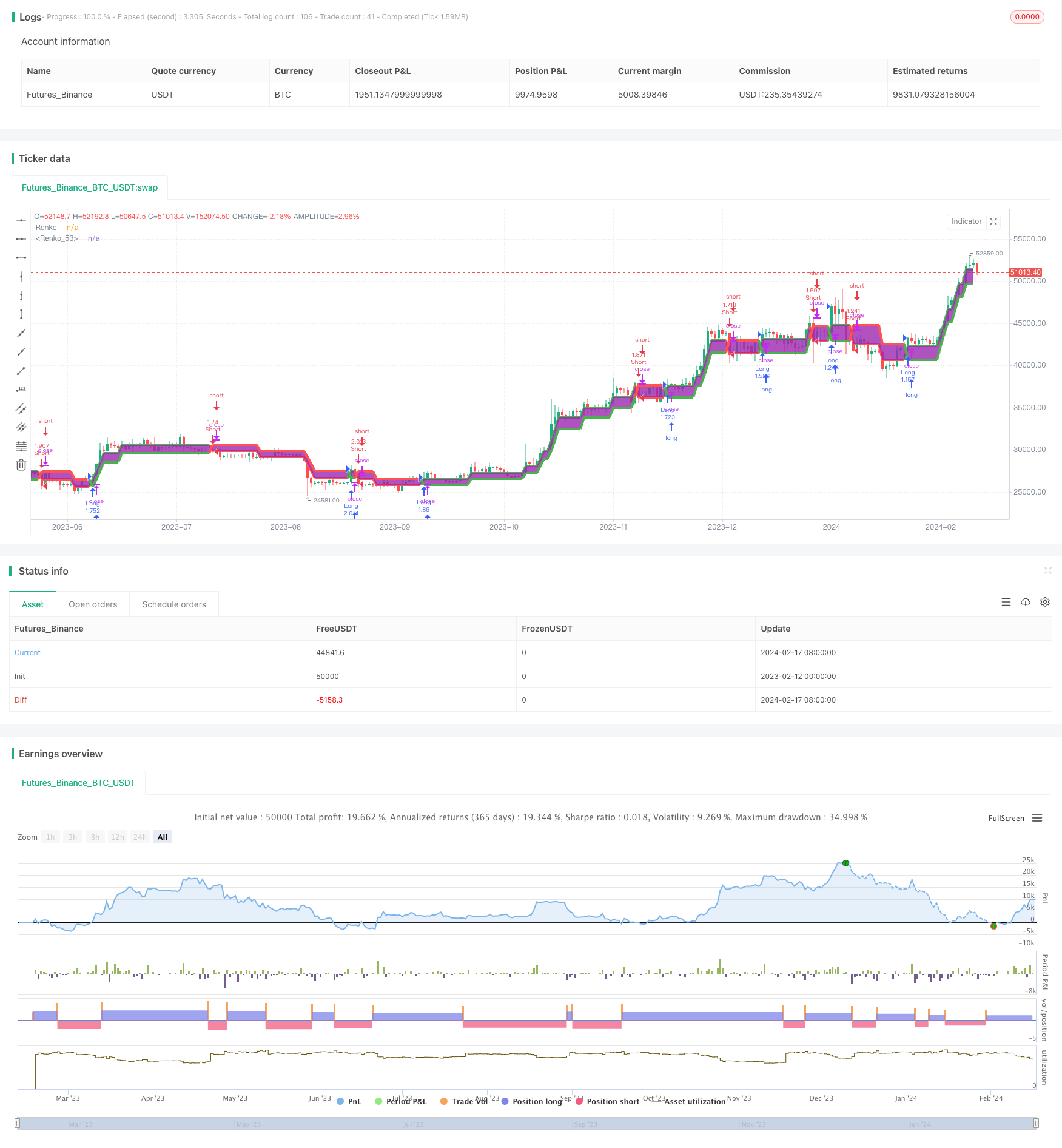
이 전략은 을 시뮬레이션하여 시장 동력의 변화를 판단하고, 의 방향에 따라 더 많은 공백을 한다.
전략 원칙
이 전략의 핵심 원칙은 ATR과 종결 가격의 관계를 계산하여 벽의 형성을 모방하는 것이다. 구체적으로, 두 개의 변수 Brick1과 Brick2을 정의한다.
Brick1의 계산 방법은: Brick1의 폐가치가 Brick1의 어제값+ATR의 값을 초과하면 Brick1은 Brick1의 어제값+ATR이 된다. 폐가치가 Brick1의 어제값-ATR의 값을 초과하면 Brick1은 Brick1의 어제값-ATR이 된다. 그렇지 않으면 Brick1은 Brick1의 어제값을 계승한다.
Brick2의 계산 방법은: Brick1값과 Brick1 어제값이 같지 않다면, Brick2는 Brick1 어제값이다; 그렇지 않으면 Brick2 어제값을 계승한다.
이렇게 하면 이 형성되는 것을 모방한다. Brick1이 올라갈 때 ATR이 넘으면 위쪽 이 형성되고, Brick1이 내려갈 때 ATR이 넘으면 아래쪽 이 형성된다. Brick2는 의 위치를 기록한다.
Brick1과 Brick2가 상향으로 교차할 때, 이 상향으로 확장되어 다목적으로 판단되는 것을 나타냅니다. Brick1과 Brick2가 하향으로 교차할 때, 이 하향으로 수축되어 공허로 판단되는 것을 나타냅니다.
전략적 이점
- ATR을 사용하여 의 형성을 판단하고, 고정된 크기의 을 사용하지 않고, 시장의 변동에 동적으로 적응할 수 있습니다.
- 의 교차를 통해 다공방향을 판단하고 동력 변화를 식별한다.
- 다른 ATR 주기를 통해 시장 동력에 대한 판단에 대한 민감성을 조정할 수 있습니다.
- 시각화 된 형성 및 교차 상황, 직관적으로 시장 움직임을 판단
전략적 위험
- ATR 크기의 선택은 전략 수익률에 영향을 미칩니다. ATR 크기가 너무 작다면, 생성되는 이 너무 많아서 더 많은 무효 신호를 생성합니다. ATR 크기가 너무 크다면, 이 너무 적어서 기회를 놓치게됩니다.
- 실제 동향은 의 형태를 따르지 않을 수도 있고, 의 교차 신호는 시장의 역전으로 거부될 수도 있다.
- 거래비용에 매우 민감해야 합니다. 그렇지 않으면, 자주 거래하는 경우, 순이익이 크게 줄어들 것입니다.
매개 변수를 최적화하여 최적의 ATR 주기를 찾을 수 있습니다. 유효하지 않은 신호에 의한 손실을 줄이기 위해 스톱 스톱 전략을 조정할 수 있습니다. 비용과 수익의 영향을 줄이기 위해 거래 품종을 적절히 확대할 수 있습니다.
전략 최적화
- 다른 지표와 결합하여 신호를 필터링 할 수 있습니다. 예를 들어 양 에너지 지표, 진동 지표 등, 무효 신호를 피합니다.
- 트렌드 필터를 추가하여 트렌드 방향으로만 신호를 발산하여 역전 손실을 방지합니다.
- 테스트 기간 동안 전체 샘플 변수를 최적화하는 방법을 사용하여 자동으로 최적의 변수를 찾습니다.
요약하다
이 전략은 동적 모의 의 교차를 통해 시장의 단기 경향과 동력을 판단하고, 시각화 형태를 직관적으로 보여준다. 전략 최적화 공간은 넓고, 매개 변수 최적화 및 신호 필터링은 안정성을 더욱 높일 수 있다.
/*backtest
start: 2023-02-12 00:00:00
end: 2024-02-18 00:00:00
period: 1d
basePeriod: 1h
exchanges: [{"eid":"Futures_Binance","currency":"BTC_USDT"}]
*/
//@version=4
///Component Code Start
testStartYear = input(2017, "Backtest Start Year")
testStartMonth = input(01, "Backtest Start Month")
testStartDay = input(1, "Backtest Start Day")
testPeriodStart = timestamp(testStartYear, testStartMonth, testStartDay, 0, 0)
testStopYear = input(2025, "Backtest Stop Year")
testStopMonth = input(1, "Backtest Stop Month")
testStopDay = input(1, "Backtest Stop Day")
testPeriodStop = timestamp(testStopYear, testStopMonth, testStopDay, 0, 0)
/// A switch to control background coloring of the test period
testPeriodBackground = input(title="Color Background?", type=input.bool, defval=false)
testPeriodBackgroundColor = testPeriodBackground and time >= testPeriodStart and time <= testPeriodStop ?
#00FF00 : na
bgcolor(testPeriodBackgroundColor, transp=97)
testPeriod() => true
/// Component Code Stop
//Zack_the_Lego (original AUTHOR) made into strategy by mkonsap
strategy("Flex Renko Emulator", overlay=true, default_qty_type=strategy.percent_of_equity, default_qty_value=100)
margin = input(true, title="Margin?")
Margin = margin ? margin : false
res = input(type=input.resolution, defval="D", title="Resolution of ATR")
xATR = atr(14)
//TF = x78tf ? "78" : "39"
BrickSize = security(syminfo.tickerid, res, xATR)
//Brick1 = close > nz(Brick1[1]) + BrickSize ? nz(Brick1[1]) + BrickSize : close <
//nz(Brick1[1]) - BrickSize ?
//nz(Brick1[1]) - BrickSize
//: nz(Brick1[1]))
Brick1() =>
s1 = 0.0
s1 := close > nz(s1[1]) + BrickSize ? nz(s1[1]) + BrickSize :
close < nz(s1[1]) - BrickSize ? nz(s1[1]) - BrickSize : nz(s1[1])
s1
Brick2() =>
s2 = 0.0
Brick1_1 = Brick1()
s2 := Brick1() != Brick1()[1] ? Brick1_1[1] : nz(s2[1])
s2
colorer = Brick1() > Brick2() ? color.green : color.red
p1 = plot(Brick1(), color=colorer, linewidth=4, title="Renko")
p2 = plot(Brick2(), color=colorer, linewidth=4, title="Renko")
fill(p1, p2, color=color.purple, transp=50)
mylong = crossover(Brick1(), Brick2())
myshort = crossunder(Brick1(), Brick2())
last_long = float(na)
last_short = float(na)
last_long := mylong ? time : nz(last_long[1])
last_short := myshort ? time : nz(last_short[1])
in_long = last_long > last_short ? 2 : 0
in_short = last_short > last_long ? 2 : 0
mylong2 = crossover(Brick1(), Brick2())
myshort2 = crossunder(Brick1(), Brick2())
last_long2 = float(na)
last_short2 = float(na)
last_long2 := mylong2 ? time : nz(last_long2[1])
last_short2 := myshort2 ? time : nz(last_short2[1])
in_long2 = last_long2 > last_short2 ? 0 : 0
in_short2 = last_short2 > last_long2 ? 0 : 0
condlongx = in_long + in_long2
condlong = crossover(condlongx, 1.9)
condlongclose = crossunder(condlongx, 1.9)
condshortx = in_short + in_short2
condshort = crossover(condshortx, 1.9)
condshortclose = crossunder(condshortx, 1.9)
// === STRATEGY - LONG POSITION EXECUTION WITH CLOSE ORDERS ===
//enterLong() => crossover(condlongx, 1.9) and testPeriod() and strategy.position_size <= 0
//exitLong() => crossunder(condlongx, 1.9) and testPeriod() and strategy.position_size > 0
//strategy.entry(id = "Long", long = true, when = enterLong())
//strategy.close(id = "Long", when = exitLong())
// === STRATEGY - SHORT POSITION EXECUTION WITH CLOSE ORDER===
//enterShort() => crossover(condshortx, 1.9) and testPeriod() and strategy.position_size >= 0 and Margin
//exitShort() => crossunder(condshortx, 1.9) and testPeriod() and strategy.position_size < 0
//strategy.entry(id = "Short", long = false, when = enterShort())
//strategy.close(id = "Short", when = exitShort())
//END
///STRATEGY ONLY LONG AND SHORT/////
if crossover(condlongx, 1.9) and testPeriod() and strategy.position_size <= 0
strategy.entry("Long", strategy.long, comment="Long")
if crossover(condshortx, 1.9) and testPeriod() and strategy.position_size >= 0
strategy.close("Long", when=not Margin)
if crossover(condshortx, 1.9) and testPeriod() and strategy.position_size >= 0
strategy.entry("Short", strategy.short, comment="Short", when=Margin)
/////// END ////